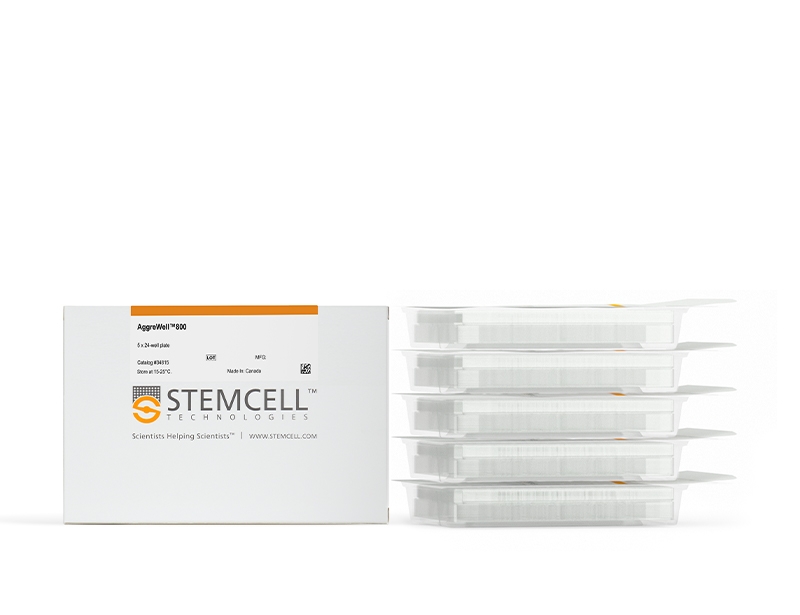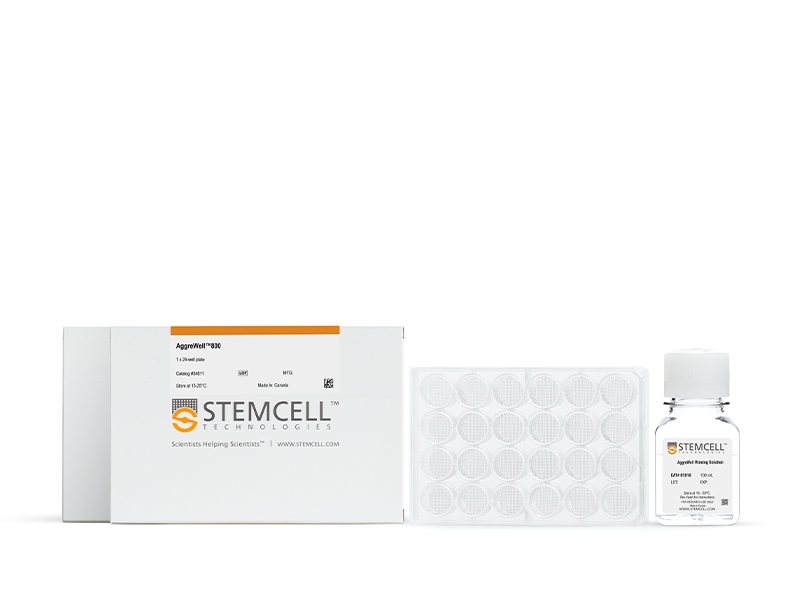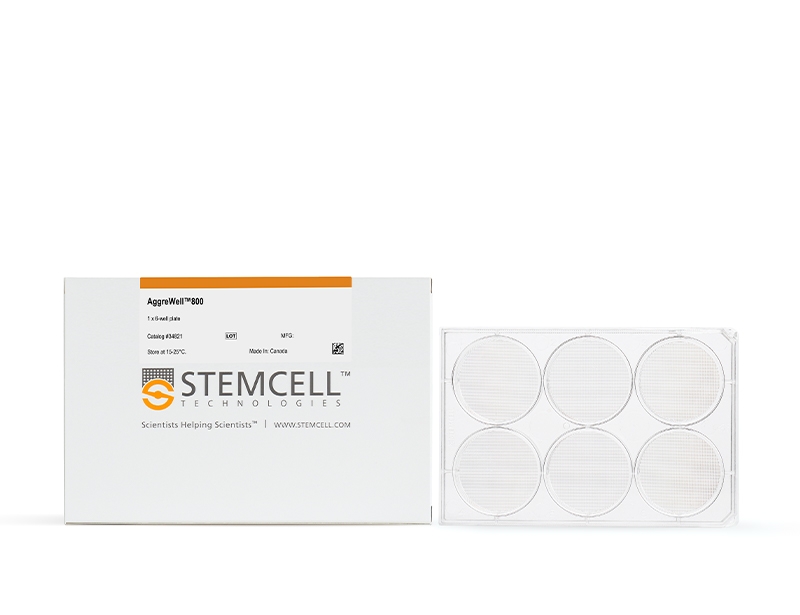概要
AggreWell™ plates bring an easy, standardized approach to the generation of cell aggregates, including embryoid bodies (EBs) and spheroids. EBs and spheroids generated using AggreWell™ plates are consistent in size and shape, and are uniform within and between experiments. New and improved second-generation AggreWell™ plates are compatible with a variety of cell types, including ES and iPS cells, cancer cells and more. Enhanced optical characteristics provide crystal clear imaging. Note: Anti-Adherence Rinsing Solution is required for optimal EB and spheroid formation.
If you use AggreWell™400 plates, please see here.
If you use AggreWell™400 plates, please see here.
技术资料
| Document Type | 产品名称 | Catalog # | Lot # | 语言 |
|---|---|---|---|---|
| Product Information Sheet | AggreWell™800 24-well Plate, 1 pack | 34811 | All | English |
| Product Information Sheet | AggreWell™800 24-well Plate, 5 pack | 34815 | All | English |
| Product Information Sheet | AggreWell™800 24-well Plate Starter Kit | 34850 | All | English |
| Product Information Sheet | AggreWell™800 6-well plate, 1 pack | 34821 | All | English |
| Product Information Sheet | AggreWell™800 6-well plate, 5 pack | 34825 | All | English |
| Product Information Sheet | AggreWell™800 6-well Starter Kit | 34860 | All | English |
数据及文献
Publications (8)
Viruses 2020 mar
Modelling Lyssavirus Infections in Human Stem Cell-Derived Neural Cultures.
Abstract
Abstract
Rabies is a zoonotic neurological infection caused by lyssavirus that continues to result in devastating loss of human life. Many aspects of rabies pathogenesis in human neurons are not well understood. Lack of appropriate ex-vivo models for studying rabies infection in human neurons has contributed to this knowledge gap. In this study, we utilize advances in stem cell technology to characterize rabies infection in human stem cell-derived neurons. We show key cellular features of rabies infection in our human neural cultures, including upregulation of inflammatory chemokines, lack of neuronal apoptosis, and axonal transmission of viruses in neuronal networks. In addition, we highlight specific differences in cellular pathogenesis between laboratory-adapted and field strain lyssavirus. This study therefore defines the first stem cell-derived ex-vivo model system to study rabies pathogenesis in human neurons. This new model system demonstrates the potential for enabling an increased understanding of molecular mechanisms in human rabies, which could lead to improved control methods.
Frontiers in bioengineering and biotechnology 2020
Maturation of Human Pluripotent Stem Cell-Derived Cerebellar Neurons in the Absence of Co-culture.
Abstract
Abstract
The cerebellum plays a critical role in all vertebrates, and many neurological disorders are associated with cerebellum dysfunction. A major limitation in cerebellar research has been the lack of adequate disease models. As an alternative to animal models, cerebellar neurons differentiated from pluripotent stem cells have been used. However, previous studies only produced limited amounts of Purkinje cells. Moreover, in vitro generation of Purkinje cells required co-culture systems, which may introduce unknown components to the system. Here we describe a novel differentiation strategy that uses defined medium to generate Purkinje cells, granule cells, interneurons, and deep cerebellar nuclei projection neurons, that self-formed and differentiated into electrically active cells. Using a defined basal medium optimized for neuronal cell culture, we successfully promoted the differentiation of cerebellar precursors without the need for co-culturing. We anticipate that our findings may help developing better models for the study of cerebellar dysfunctions, while providing an advance toward the development of autologous replacement strategies for treating cerebellar degenerative diseases.
Biosensors 2019 apr
A Novel Toolkit for Characterizing the Mechanical and Electrical Properties of Engineered Neural Tissues.
Abstract
Abstract
We have designed and validated a set of robust and non-toxic protocols for directly evaluating the properties of engineered neural tissue. These protocols characterize the mechanical properties of engineered neural tissues and measure their electrophysical activity. The protocols obtain elastic moduli of very soft fibrin hydrogel scaffolds and voltage readings from motor neuron cultures. Neurons require soft substrates to differentiate and mature, however measuring the elastic moduli of soft substrates remains difficult to accurately measure using standard protocols such as atomic force microscopy or shear rheology. Here we validate a direct method for acquiring elastic modulus of fibrin using a modified Hertz model for thin films. In this method, spherical indenters are positioned on top of the fibrin samples, generating an indentation depth that is then correlated with elastic modulus. Neurons function by transmitting electrical signals to one another and being able to assess the development of electrical signaling serves is an important verification step when engineering neural tissues. We then validated a protocol wherein the electrical activity of motor neural cultures is measured directly by a voltage sensitive dye and a microplate reader without causing damage to the cells. These protocols provide a non-destructive method for characterizing the mechanical and electrical properties of living spinal cord tissues using novel biosensing methods.
Translational psychiatry 2019
Comparative characterization of human induced pluripotent stem cells (hiPSC) derived from patients with schizophrenia and autism.
Abstract
Abstract
Human induced pluripotent stem cells (hiPSC) provide an attractive tool to study disease mechanisms of neurodevelopmental disorders such as schizophrenia. A pertinent problem is the development of hiPSC-based assays to discriminate schizophrenia (SZ) from autism spectrum disorder (ASD) models. Healthy control individuals as well as patients with SZ and ASD were examined by a panel of diagnostic tests. Subsequently, skin biopsies were taken for the generation, differentiation, and testing of hiPSC-derived neurons from all individuals. SZ and ASD neurons share a reduced capacity for cortical differentiation as shown by quantitative analysis of the synaptic marker PSD95 and neurite outgrowth. By contrast, pattern analysis of calcium signals turned out to discriminate among healthy control, schizophrenia, and autism samples. Schizophrenia neurons displayed decreased peak frequency accompanied by increased peak areas, while autism neurons showed a slight decrease in peak amplitudes. For further analysis of the schizophrenia phenotype, transcriptome analyses revealed a clear discrimination among schizophrenia, autism, and healthy controls based on differentially expressed genes. However, considerable differences were still evident among schizophrenia patients under inspection. For one individual with schizophrenia, expression analysis revealed deregulation of genes associated with the major histocompatibility complex class II (MHC class II) presentation pathway. Interestingly, antipsychotic treatment of healthy control neurons also increased MHC class II expression. In conclusion, transcriptome analysis combined with pattern analysis of calcium signals appeared as a tool to discriminate between SZ and ASD phenotypes in vitro.
STEM CELLS Translational Medicine 2016 NOV
A Novel Protocol for Directed Differentiation of C9orf72-Associated Human Induced Pluripotent Stem Cells Into Contractile Skeletal Myotubes
Abstract
Abstract
: Induced pluripotent stem cells (iPSCs) offer an unlimited resource of cells to be used for the study of underlying molecular biology of disease, therapeutic drug screening, and transplant-based regenerative medicine. However, methods for the directed differentiation of skeletal muscle for these purposes remain scarce and incomplete. Here, we present a novel, small molecule-based protocol for the generation of multinucleated skeletal myotubes using eight independent iPSC lines. Through combinatorial inhibition of phosphoinositide 3-kinase (PI3K) and glycogen synthase kinase 3β (GSK3β) with addition of bone morphogenic protein 4 (BMP4) and fibroblast growth factor 2 (FGF2), we report up to 64% conversion of iPSCs into the myogenic program by day 36 as indicated by MYOG+ cell populations. These cells began to exhibit spontaneous contractions as early as 34 days in vitro in the presence of a serum-free medium formulation. We used this protocol to obtain iPSC-derived muscle cells from frontotemporal dementia (FTD) patients harboring C9orf72 hexanucleotide repeat expansions (rGGGGCC), sporadic FTD, and unaffected controls. iPSCs derived from rGGGGCC carriers contained RNA foci but did not vary in differentiation efficiency when compared to unaffected controls nor display mislocalized TDP-43 after as many as 120 days in vitro. This study presents a rapid, efficient, and transgene-free method for generating multinucleated skeletal myotubes from iPSCs and a resource for further modeling the role of skeletal muscle in amyotrophic lateral sclerosis and other motor neuron diseases. SIGNIFICANCE Protocols to produce skeletal myotubes for disease modeling or therapy are scarce and incomplete. The present study efficiently generates functional skeletal myotubes from human induced pluripotent stem cells using a small molecule-based approach. Using this strategy, terminal myogenic induction of up to 64% in 36 days and spontaneously contractile myotubes within 34 days were achieved. Myotubes derived from patients carrying the C9orf72 repeat expansion show no change in differentiation efficiency and normal TDP-43 localization after as many as 120 days in vitro when compared to unaffected controls. This study provides an efficient, novel protocol for the generation of skeletal myotubes from human induced pluripotent stem cells that may serve as a valuable tool in drug discovery and modeling of musculoskeletal and neuromuscular diseases.
Journal of Neuroscience 2016 JUL
A New Glucocerebrosidase Chaperone Reduces -Synuclein and Glycolipid Levels in iPSC-Derived Dopaminergic Neurons from Patients with Gaucher Disease and Parkinsonism
Abstract
Abstract
UNLABELLED Among the known genetic risk factors for Parkinson disease, mutations in GBA1, the gene responsible for the lysosomal disorder Gaucher disease, are the most common. This genetic link has directed attention to the role of the lysosome in the pathogenesis of parkinsonism. To study how glucocerebrosidase impacts parkinsonism and to evaluate new therapeutics, we generated induced human pluripotent stem cells from four patients with Type 1 (non-neuronopathic) Gaucher disease, two with and two without parkinsonism, and one patient with Type 2 (acute neuronopathic) Gaucher disease, and differentiated them into macrophages and dopaminergic neurons. These cells exhibited decreased glucocerebrosidase activity and stored the glycolipid substrates glucosylceramide and glucosylsphingosine, demonstrating their similarity to patients with Gaucher disease. Dopaminergic neurons from patients with Type 2 and Type 1 Gaucher disease with parkinsonism had reduced dopamine storage and dopamine transporter reuptake. Levels of α-synuclein, a protein present as aggregates in Parkinson disease and related synucleinopathies, were selectively elevated in neurons from the patients with parkinsonism or Type 2 Gaucher disease. The cells were then treated with NCGC607, a small-molecule noninhibitory chaperone of glucocerebrosidase identified by high-throughput screening and medicinal chemistry structure optimization. This compound successfully chaperoned the mutant enzyme, restored glucocerebrosidase activity and protein levels, and reduced glycolipid storage in both iPSC-derived macrophages and dopaminergic neurons, indicating its potential for treating neuronopathic Gaucher disease. In addition, NCGC607 reduced α-synuclein levels in dopaminergic neurons from the patients with parkinsonism, suggesting that noninhibitory small-molecule chaperones of glucocerebrosidase may prove useful for the treatment of Parkinson disease. SIGNIFICANCE STATEMENT Because GBA1 mutations are the most common genetic risk factor for Parkinson disease, dopaminergic neurons were generated from iPSC lines derived from patients with Gaucher disease with and without parkinsonism. These cells exhibit deficient enzymatic activity, reduced lysosomal glucocerebrosidase levels, and storage of glucosylceramide and glucosylsphingosine. Lines generated from the patients with parkinsonism demonstrated elevated levels of α-synuclein. To reverse the observed phenotype, the neurons were treated with a novel noninhibitory glucocerebrosidase chaperone, which successfully restored glucocerebrosidase activity and protein levels and reduced glycolipid storage. In addition, the small-molecule chaperone reduced α-synuclein levels in dopaminergic neurons, indicating that chaperoning glucocerebrosidase to the lysosome may provide a novel therapeutic strategy for both Parkinson disease and neuronopathic forms of Gaucher disease.

 网站首页
网站首页












